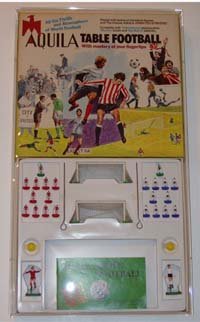
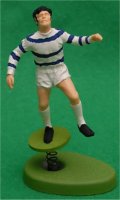
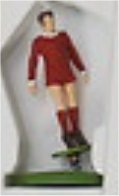
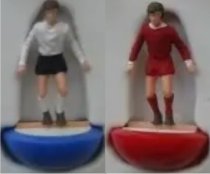
| Peter Upton's |
Subbuteo Tribute Website. |
|
Miscellaneous Items |
|
Not Quite Subbuteo - Peter Adolph's later work, and a Belgian mystery. |
This page aims to briefly cover three games which have surfaced within the Subbuteo community in the last decade.
Aquila and Atlantica Mini-Baseball were both games that Peter Adolph worked on after leaving Waddingtons. Neither game passed the prototype stage in Peter Adolph's lifetime, although the co-producer of Atlantica, David Morrison Wilpred, did get a limited run of this baseball game produced in the 1990s. I'd resisted putting these two games onto the website until now, as the research on them has been done by others, and I have no great experience of them. However, for completeness sake, they now have this page. The information on these items is mostly taken from two Subbuteo books: Fifty Years of Flicking Football by Richard Payne, and Growing Up with Subbuteo by Mark Adolph, both of which are essential reading.
Subbuteo Ice Hockey is perhaps an even stranger item. Although it does have the Subbuteo name on the box, and some undoubted Subbuteo contents, its history is rather mysterious, and it may well be an unofficial product by Peter Adolph's Belgian distributors.
Aquila Table Football (Prototype) - early
1970s.
Modern Jargon, Modern Packs, Modern Game!




After Waddingtons bought out Subbuteo Sports Games Ltd in 1968, inventor Peter Adolph was retained as a director and consultant. However, Adolph felt he was not being listened to, and the relationship was short-lived. This resulted in him resigning from the company in 1970, and as if to prove a point, he immediately set about designing what he hoped would be a superior table football game. Aquila was the Latin name for an eagle, and Adolph had already used it for a subsidiary company in Barcelona (who would also work on the game).
The story is told delightfully by Peter Adolph's son, Mark, in his book Growing Up With Subbuteo. Mark, who was around fourteen years old at the time, was thrilled to be helping his Dad out with a new game. Most of the set does appear to be a copy of Subbuteo, and the rules show the figures being flicked in an identical way. Mark mentions that the new figures were in an "up-to-date" style with 1970s haircuts, but that his Dad also wanted to produce "vintage" figures in baggy shorts to recreate famous matches.
The key difference with Subbuteo was the use of a larger 2 inch striker figure for set pieces, a concept suggested by Mark. These were mounted on a spring, and set into a heavy lead weighted base (for stability). The idea was that you could rebound aerial balls off this figure for impressive realistic goal mouth action. The figures were manufactured in three different poses - two jumping to head the ball (arms up, and arms down), and a player in mid volley. Mark mentions that "thousands" of these figures were duly produced, and that he spent much of his holidays and lunch times painting the things. He liked the fact that the different figures produced an array of different random deflections.
April 2024: The two large scale players "heading the ball" now have larger photographs, so you can see a little better how the spring action was designed. The Liverpool player came from a full edition, and I originally assumed it was a better picture of the set I already had illustrated. However, if you study the pictures, you will see that the full set has the "arms up" player painted as Liverpool, rather than this one, who is "arms down". The Queens Park Rangers player is from a single accessory set, and the box is discussed below. The team players are suitably different than the Subbuteo heavyweight of the period, although they do have a hint of TAF 4-2-4 about them.
A box illustration was commissioned, and prototypes assembled. Eventually, the product was shown to Waddingtons*, but understandably they were unimpressed and annoyed by this possible rival. Lawyers were threatened, and Peter Adolph backed down. Mark mentions that Waddingtons had shown some interest in the large striker figures as a possible addition to the Subbuteo accessory range, perhaps matching up with the larger corner kickers who had been introduced in 1972. In the end, of course, nothing came of it.
Apparently around twelve prototype sets were produced in all, plus extra team squads and strikers. Luckily, some of these were kept safe by Mark.
*Richard Payne's Fifty Years of Flicking Football book dates this meeting to 1973.
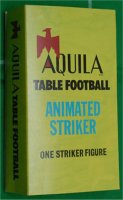
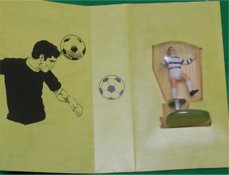
This surviving boxed prototype "Animated Striker" exists within the collecting community. The box has quite a simple fold-over design. The wording on the back of the box explains that the striker is for use with any table soccer game, so obviously Peter Adolph was hoping to pick up extra sales from existing Subbuteo Table Soccer players. Obviously, like Subbuteo's own corner kickers, the striker added "fun" to the game as played by children, rather than anything more serious.
As previously explained, Mark Adolph mentions in his biography of his father that they painted "thousands" of figures for the game. I assume not too many of the Strikers exist though, and I guess it would be pleasing for Peter Adolph to know that the one surviving here is in the colours of his beloved Queens Park Rangers.
The back of the box gives a few more hints to the nature of Aquila table football - clearly advertised as "New - to any soccer game!" As well as the "animated all-action striker figures that really head for goal", the following details are given:-
Interchangeable double colour bases.
"Old timer" teams. Mark Adolph has spoken of the idea of having a "baggy shorts" player to represent classic matches - about 30 years before these figures started appearing in the community.
Munich "keep-in" goals.
Big Match ball
International pitch (your guess is as good as mine!!)
A new limited company - Aquila Limited, with that magical Langton Green address, was mentioned on the box, as well as Aquila S.L. in Barcelona, who had made Subbuteo for Adolph in the 1960s. A plastics company based in England and Wales are also mentioned, who I assume held the moulds.
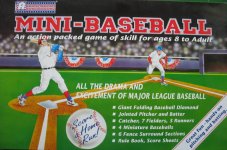
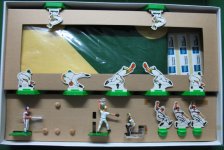
This was a further attempt by Peter Adolph to return to the toy business, after perhaps a decade away from it. Mark Adolph's book again has useful details. He states that his Dad mentioned producing a baseball game out of the blue, as he felt that America was an untapped market. Mark admits that neither of them knew anything about baseball, and that they had to buy books to research it (eventually flying to New York to watch a few games). This was in the late 1970s. Interestingly, Richard Payne's book Fifty Years of Flicking Football states that "shortly before his resignation from Subbuteo, Peter made two trips to America to study the possibility of producing a three dimensional baseball game. Waddingtons decided not to pursue an interest in the game, and Peter tried to develop it himself". Richard Paine actually met up with Peter Adolph many times whilst producing his book, and had seen the production model. With Subbuteo tentatively dipping into the American market in the late 1970s, with a NASL team range, and eventual link up with Jokari, I wonder whether this was another attempt by Peter Adolph to remind them what they were missing.
To aid with this project, Adolph enlisted David Morrison Wilpred, an experienced Subbuteo marketing manager who was just retiring, and looking for a new venture. They formed a company together, but sadly, the design work became costly, and eventually Peter Adolph decided that he had ploughed too much of his money into it. They looked for further investment without success. In Richard Paine's book (produced in 1996), that appears to be the end of the story, but actually the game was produced (possibly in a small run) by David Morrison Wilpred, and examples exist within the Subbuteo community.
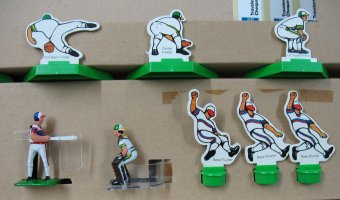
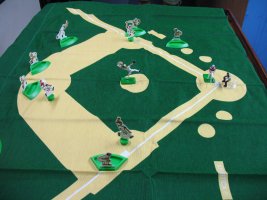
Sadly, the game as produced was a bit of a budget version, as only the pitcher, batter and catcher were produced in plastic. The fielders and runners were made of flat card on plastic bases. The promotional picture of the game shown in Fifty Years of Flicking Football clearly shows proper 3D figures for all the fielders and runners.
Not unexpectedly, even after all the research, the game still looks and plays like the old Peter Pan cricket game, which is probably familiar to most site visitors of a certain age. The ball is made from cork, and is therefore pretty light. The bowling action is satisfying, and batting is quite straightforward due to the large clear plastic "bat". I don't think the backstop is going to get much use, which is perhaps a contrast with real baseball. The fielders are on big catching bases.
The key difference between this and the various British cricket games, were probably the "sliding fielders" who sat on weighted bases allowing for (flicked?) movement around the pitch. Mark Adolph's book states that a lot of time was spent trying to find the right surface for the pitch to allow this. Sadly, the instruction books in this borrowed version were shrink wrapped, and I didn't want to tamper with them - so the exact method of movement is still a mystery to me (for now). Again, after all the research, the set ended up with a threaded cloth pitch, like those that were so unloved in Subbuteo sets of the 1990s, albeit the baseball pitch is a thicker material. What is surprising is that the pitch is absolutely huge - the picture above shows it on a Subbuteo table from my local club - the outfield beyond the white line is hanging over the edge. You'd need a big table, and a big house. (I guess more American's would have the room for it!).
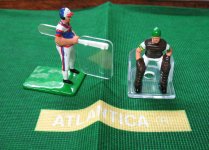
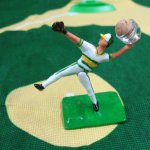
Thanks to Paul Woodhouse for letting me get his mint set out of the box to photograph and play about with! Luckily, we didn't lose any of the balls....
Subbuteo Hockey sur Glace de Table (Ice Hockey).
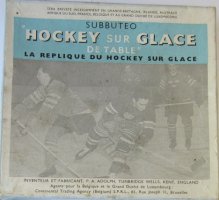
Now this is a strange little set. It first appeared on eBay way back in 2005, but with small details and a (very) big price. The collecting community were already having to deal with various eBay faking issues at this time, and the set did not look quite right to me. So I filed it under "wait for more information".....
In 2014 (and with no more information or other sets having come to light), the same set was re-listed on eBay, with better pictures. My understanding is that this solitary set (so far) came from an attic in Holland. At first glance this does appear to be a newly discovered Subbuteo set of the late 1950s/early 1960s produced for the Belgian market. Certainly, the owner of the set was convinced that this was produced by Peter Adolph in Tunbridge Wells. However, it does seem improbable that Adolph would choose not to launch a game in his own country (and biggest market), and studying the pictures in detail, there are issues that need resolving.
Lets start with looking at what the set contains....
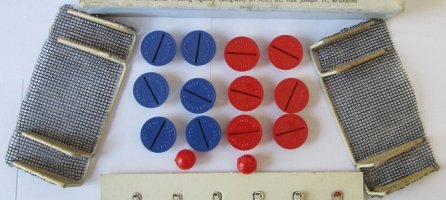
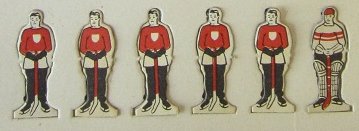
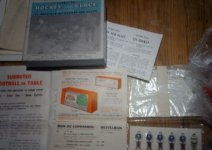
At its heart, the set is simply a variation on Subbuteo Fivesides. The box is the size of the small Fivesides set of the late 1950s (i.e. without a pitch), and the goals too are clearly from Fivesides. The set as shown has balls rather than a puck, and these are cricket balls rather than the brown Fivesides version. The balls look like the later 1960s cricket balls (assuming they are genuine to the set). The ice hockey components are limited to the paperwork, which means the (cardboard) teams of course, and the Belgian playing instructions. The set included the usual Belgian Subbuteo football advertising leaflet of the period (with no mention of ice hockey in it of course).
So is this a lost Subbuteo set? Could it somehow be missing from all of Peter Adolph's advertising paperwork, and released solely in Belgium? I have my doubts, and other collectors of this era seem in agreement with me. Here are the main talking points.....
1. The Box does not match others of the period.
Peter Adolph does not have photo covers on his boxes. Okay, he does used them behind the titles, but not like this, and the black and white cover is far less distinctive than some of the more colourful boxes. In this period, the sports games were beginning to come together with a unified look. This is a radical departure.
2. The fonts and general layout do not match the other sets of the period.
Another reason why the box looks wrong. The racing games do have shadowing on the titles, but in a joined up hand-writing style. However, the font for Subbuteo does match the Belgian football set of the period (see below).
3. There are no copyright/trademark symbols on the box, and where are the patents?
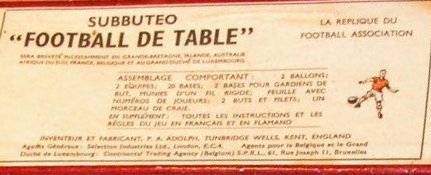
![]()
This was going to be my clincher, as all the standard British sets had the familiar "regd" mark attached to the word Subbuteo. However, if you look at the early Belgian and Dutch sets, the trademark is missing.
A significant clue to this puzzle could be the Belgian agents who get a credit on the box - Continental Trading Agency (Belgium). They also appear as agents on one of the early Belgian football sets, and as you can see, the Subbuteo font is very similar, and is lacking the "regd" trademark. If anything, this suggests to me that these boxes were produced by the distributors, rather than by Peter Adolph himself.
4. Do the teams look right?
Actually, the beautifully designed teams do look the part. They look the standard Subbuteo shape, and the static stance is fine. The one issue here is that when the players are stuck into the bases, the feet and the stick would disappear into the slot. If you look at the footballers or the cricketers, it is obvious that Peter Adolph does not make this mistake.
5. The goals - and the balls.
Although the goals look superficially like Ice Hockey (especially if used the wrong way up) they are not really right. I think Peter Adolph would have made a proper version, probably allowing movement of the goalkeeper from behind, as with football. Note that the goalkeepers do not have rods, and this does seems odd. The balls are another strange decision, as obviously you don't have a ball in ice hockey.
Is it really likely that Peter Adolph would have produced a new sports game, and not released it in the UK? Especially if it was just a case of altering the figures, as was done with the racing games? There was really no extra expense here at all. It would have cost nothing to put the set in the companion games catalogue. It could be argued that ice hockey is a minority sport in the UK, unlike Adolph's other chosen sports of the period (speedway had huge interest at the time). Was Belgium a hotbed of ice hockey?
An argument can be made to suggest that Ice Hockey is similar to another 1950s rarity, "By Spacecraft to the Moon". That Subbuteo space game was a budget version of the better known Journey into Space, but does not seem to be advertised with it in any of Adolph's literature. As a consequence, it is a rarity known only because of (a few?) surviving copies. Here's hoping for a UK Ice Hockey to surface then!!
More research is needed, and my feeling is that this might simply come down to whoever produced the paperwork for the 1950s overseas sets. All the Dutch, Belgian and French sets needed playing instructions in the appropriate language. Would Peter Adolph have had the skill to do this (or the right personnel?). If the import agents were printing the rules and the box labels, it would not be a big stretch for them to print the players as well.
On the lid of the fivesides set it was explained that this game was "as played at the festival of Football in London, June 1949, by Charlton, Chelsea, Brentford, Derby County, Wolverhampton, West Ham, Tottenham Hotspurs, and Romford." Was this a unique indoor format for the UK? It certainly doesn't match Futsal or other alternatives. Certainly, the full fivesides set has some resemblance to ice hockey, with the rebound surround and goals within the field of play. Whether Peter Adolph made the connection though is open to question. Perhaps someone unfamiliar with the real fivesides, spotted the potential instead.
Whatever the truth, it is a cute little set, and another quirky little side story in the life of Subbuteo!
Sadly, that's all the information I've got at present. So it's time to pick another destination.